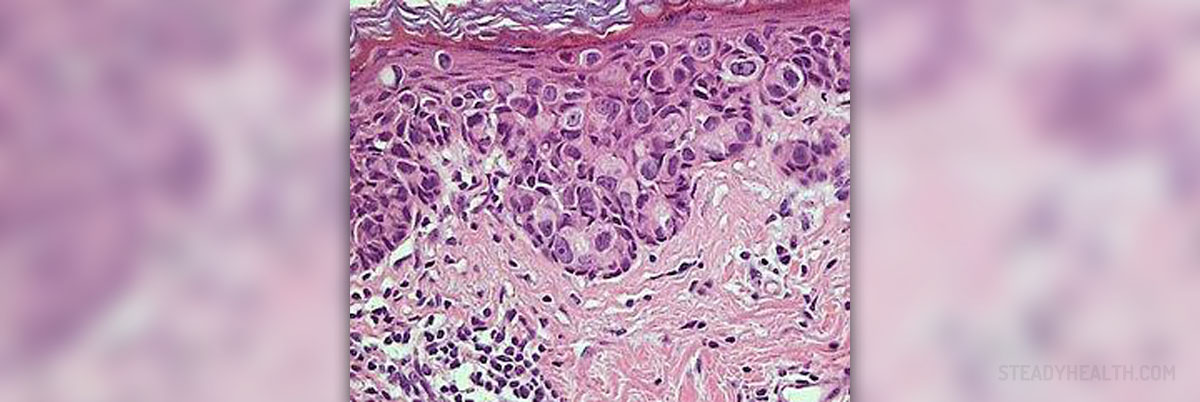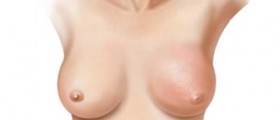
Paget's disease of the breast is a rare form of breast cancer that initially affects the nipple and after some time spreads to the very breast tissue. Apart from being an introduction to an actual breast cancer, Paget's disease many times occurs at the same time as an underlying breast cancer. It has not been fully understood the reason why Paget's disease occurs and how it influences further growth of the breast cancer.
Paget's Disease of the Breast Affects the Nipple
The condition can be easily recognized by crusting of the nipple skin while advanced stages of the disease typically lead to tingling and itchy sensation as well as increased sensitivity of the affected area. Pain and burning sensation may occur as well. The very nipple is red. Scaling and flaking occur in some cases although they do not have to be present at all. Even though the affected skin may improve in appearance, the woman should not neglect any change to the nipples and is supposed to consult her doctor as soon as possible, especially if the remnant of the above mentioned symptoms and signs linger.
What is more, there can be a discharge from the nipple, a palpable lump inside the affected breast and in advanced stages there is also enlargement of regional lymph nodes (those in the armpit).
There are two current theories associated with the onset of Paget's disease. According to the first theory, cancer cells originate from the tumor inside the breast. They detach and by moving through the milk ducts eventually reach the nipple, where they settle and start to multiply. The second theory, on the other hand, suggests that the cells of the nipple undergo malignant alteration and they themselves form the cancer. So, the second tumor, if it is located in the same breast, has nothing to do with changes affecting the nipple.
Diagnosis is easily confirmed after a biopsy of the suspicious tissue and pathological examination. These women undergo additional tests as well such as ultrasound of the breast or mammography, both of which can reveal the tumor inside the breast.
Surgery is suggested in all women suffering from Paget's disease. As far as further treatment is concerned, it basically depends on the stage of the disease, the presence of additional tumor in the same breast and several more factors. A modified mastectomy is performed if there is invasive breast cancer. If the cancer inside the breast is not invasive, a woman undergoes a simple mastectomy. Also, if the cancer is located only to the nipple and the rest of the breast is cancer-free, patients undergo lumpectomy and postoperative radiation therapy. The goal of radiation therapy is to sterilize the operated area and kill all the remnant cancer cells.
Statistical Prognosis of Survival
Prognosis of Paget's disease depends on many factors. The stage of the disease is only one of them. Infiltration of the regional lymph nodes at the time when the cancer is confirmed plays a significant role in the survival. Namely, the presence of cancer cells in the regional lymph nodes points to dissemination of the tumor. This means that some of these cells may have even managed to leave the affected lymph node and be scattered around the body. This is why any involvement of lymph nodes is not considered a good prognostic sign.
If there is no lymph node involvement, the survival rate ranges between 79% and 85% for 5-year period. In patients in whom the lymph nodes are affected at the time of the diagnosis, the survival rate ranges between 28% and 32%.
Also, the prognosis depend on the presence or absence of another tumor inside the affected breast. The survival rate in women with an additional underlying breast tumor within the period of 5 years is 38-40%. Only 22-33% of them will survive the following 10 years. If there is no underlying breast cancer, the prognosis is much better.
Finally, women who are suffering from metastatic breast cancer that accompanies mammary Paget's disease and an underlying breast cancer have 33% chance to survive the following 10 years.
Additional Data
Paget's disease is actually not so common type of breast cancer. It accounts for less than 5% of all cases of this malignant disease. In the majority of cases the tumor affects older women (above the age of 50). It is essential to differentiate Paget's disease of the breast from the condition carrying the same name but affecting the bones. There is also Paget's disease of the vulva, but it has not connection with the previously mentioned diseases.
Being a rather mysterious illness, scientist are conducting research on Paget's disease of the nipple in order to create the best way to treat it and perhaps prevent its occurrence. Since there are many new, improved treatments for breast cancer in general, it is clear that treatment for Paget's disease of the nipple will also become more efficient.

















Your thoughts on this
Loading...